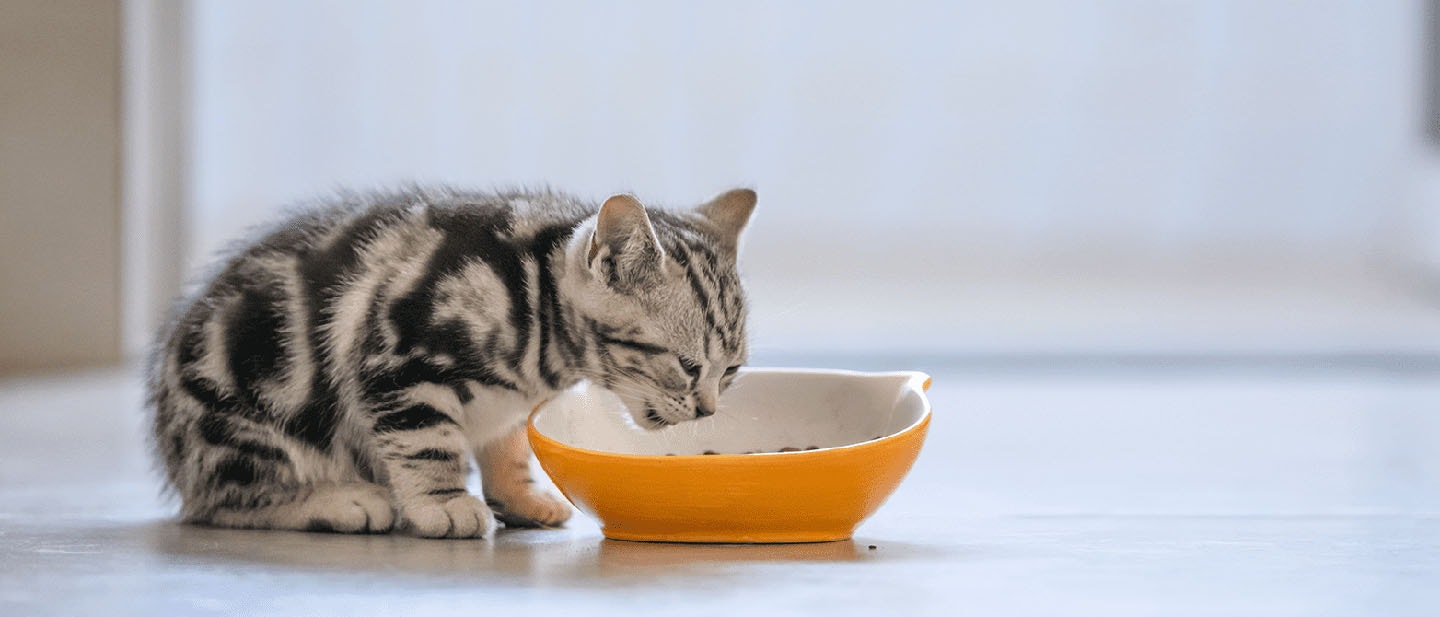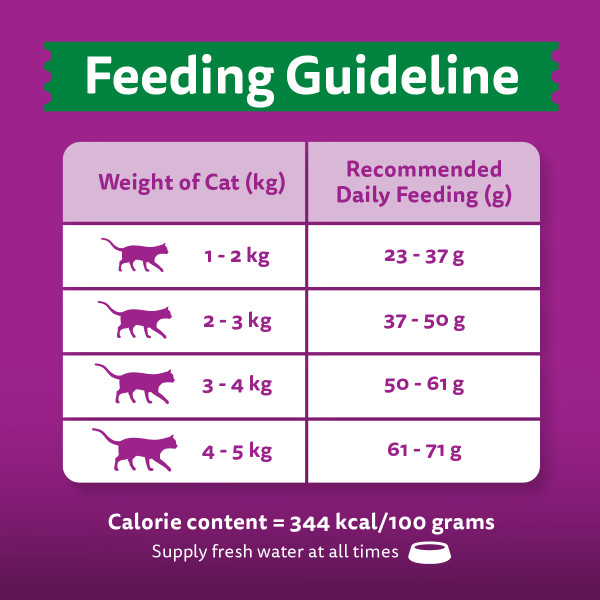
Cat Diet: Tips For Cat Nutrition
Learning how to properly feed your cat can feel overwhelming, especially if you’re a new pet parent. Deciding what goes in your cat’s bowl, figuring out how often to feed, and knowing how much food to serve can all feel tricky at first, but these are all normal challenges that every cat owner goes through. Thankfully, staying on top of cat nutrition is much easier than it seems.
Caring for your cat starts with learning the basics of a healthy cat diet. Our guide will teach you everything you need to know about cat feeding so you can keep your furry friend happy, healthy, and thriving.
What to Feed your Cat?
Cats may be known as picky eaters, but their diet still needs to be nutritionally complete and balanced. As obligate carnivores, they rely on nutrients naturally found in animal sources, so choosing the right cat food is key to their health. When planning your cat’s diet, you’ll come across several types of cat food so let’s take a closer look at your options.
Dry Cat Food
Dry cat food(open in new tab), or kibble, is a crunchy and low moisture variant of cat food. It’s made by blending ingredients like meat, grains, and vegetables and then they’re shaped into small, bite-sized pieces. It’s one of the most popular choices for cat feeding since it’s widely available, easy to serve, and can be mixed with wet cat food.
Wet Cat Food
Wet cat food(open in new tab) is a soft and moist cat food type. Normally sold in cans and pouches, it contains a high level of moisture which helps support hydration and has an amazing aroma and texture that make it appealing for picky eaters. Wet cat food can be served on its own or mixed with dry cat food.
Semi-Moist Cat Food
Semi-moist cat food is a type of diet that falls between dry kibble and wet food in texture and moisture. It often comes in pouches with meaty chunks in gravy or jelly and is known for being soft, palatable, and convenient to serve.
Cat Treats
Cat treats are small, flavorful snacks designed for occasional consumption rather than a cat’s primary diet. They come in many forms, like crunchy bites to lickable purées and are often used for training, bonding, or rewarding good behavior. While treats can add variety and enjoyment, they should only supplement your cat’s regular meals since they are not nutritionally complete or balanced.
When choosing cat treats, it helps to look for options that offer added health benefits. For example, cat treats like Sheba(open in new tab) and Temptations(open in new tab) are vitamin packed and low-calorie choices that let you bond with your cat without compromising their diet.
Homemade Cat Food
Homemade cat food or also known as home-prepared food (HPF), refers to meals made at home using everyday ingredients. Many pet parents choose this option believing it to be more natural or healthier for their cats.
Unfortunately, most homemade cat food lacks essential nutrients that are required in an ideal cat diet. Without an expert formulation, it can be difficult to provide the right balance of nutrients. This is why it’s generally better to go for complete and balanced cat food products(open in new tab) like WHISKAS®, which are specially formulated to meet your cat’s nutritional needs.
How Many Times to Feed a Cat?
The ideal cat eating schedule can depend on individual factors like a cat’s age, life stage, and lifestyle. Generally, it’s recommended that the average adult cat does well with two to three meals per day while the recommended feeding guideline for kittens(open in new tab) is 3 to 4 times. But when it comes to feeding approach, cat parents typically choose between meal feeding and free feeding.
Meal Feeding Cats
Meal feeding means offering food at set times rather than leaving it out all day. For example, you can follow a 12-hour window and feed your cat at 7AM and 5PM. This method makes it easier to control portions, prevent overeating, and monitor your cat’s appetite, which helps spot changes that might signal health concerns.
Free Feeding Cats
Free feeding is when food is left out all day for cats to eat whenever they choose. This approach can only be done with dry food, since wet food spoils quickly. It’s important to measure the correct daily portion and avoid topping up the bowl, otherwise your cat may overeat. Any dry food left out for more than a day should be discarded to maintain freshness.
While free feeding lets cats follow their own eating schedule, it can make it harder to track how much they’re eating. Especially for multi-cat households, it may also lead to one cat eating more than their share, increasing the risk of overeating and weight gain.

How Much to Feed a Cat?
The amount you should feed your cat depends mainly on their weight, age, and activity level. Commercial cat foods like WHISKAS® include clear feeding guidelines on the packaging, which are the best place to start. These recommendations are based on average weight ranges to help ensure your cat gets the right balance of nutrients without overeating. Let’s take a look at the example below.
For example, if your adult cat weighs between 2–3kg, the suggested portion size of WHISKAS® Dry Tuna(open in new tab) is 37–50g per day. From there, you can adjust slightly depending on how your cat responds. You can add a little more kibble if they seem underfed or reduce the amount if they are gaining too much weight.
Always remember that feeding guides are starting points. Monitoring your cat’s body condition or their level of daily activity will help you fine-tune their daily portions. And since no two cats are exactly alike, it’s important to also consider the different factors that can affect their feeding needs.
Factors That Affect a Cat's Feeding Amount
Feeding guidelines provide a useful baseline, but every cat has unique needs. Elements such as life stage, activity level, health, and even breed can all influence how many calories your cat requires. Keeping these in mind will help you make smarter adjustments to their diet.
Life Stage
Kittens need more calories to fuel rapid growth, while adult cats require steady but controlled portions to maintain a healthy weight. Senior cats may need fewer calories, though higher-quality protein becomes especially important to maintain muscle mass. Beyond calorie requirements, your cat’s life stage also determines the type of food they need, making it important to choose age-appropriate food variants. If you’re feeding a growing kitten, options like WHISKAS® Junior(open in new tab) are an excellent choice as it is specially formulated to meet the nutritional needs of kittens.
Lifestyle and Level of Activity
Active, outdoor cats burn more energy exploring, climbing, and playing, so they usually need more food to keep up with their lifestyle. Indoor cats, on the other hand, may lead more sedentary lives and should be fed carefully to avoid unnecessary weight gain.
Health Status
A cat’s health condition plays a big role in their diet. For instance, overweight cats should be fed fewer calories under veterinary guidance, while cats with medical issues like diabetes or kidney disease may require special prescription diets.
Spay or Neutered
Spayed or neutered cats typically have a slower metabolism and may be less active. This means they often need fewer calories than intact cats to maintain a healthy weight.
Breed
While not as significant as the rest, some cat breeds have faster metabolisms and naturally stay lean. Cat breeds like British Shorthairs(open in new tab) are known to be prone to obesity so they should have their portion sized monitored closely.
How to Introduce a Diet to My Cat?
When transitioning your cat to a new diet, it is essential to introduce the new food gradually to assess your cat's reaction to it. Begin by mixing 25% new food with 75% of their current food. Over the next few days, steadily increase the proportion of new food while reducing the old food, keeping in mind to maintain the total daily food intake.
Importance of Weight Management in Cats
If your cat eats too much, you might notice weight gain, inactivity or other related health issues. Obesity is the most common nutritional disorder in domestic cats and is defined as being at least 20% above normal weight. Obesity in cats can give rise to other pressing health concerns such as Type-2 diabetes, high blood pressure, osteoarthritis, and heart disease. For your cat’s health and longevity, ensuring a healthy cat weight(open in new tab) will be key.
Tips for Encouraging Exercise in Cats
Given that adult cats often run the risk of obesity if they are overfed, it is important to make sure they are getting sufficient physical exercise to burn excess calories. So, if you are looking to give your little munchkin a little encouragement to get started on an exercise routine, here are some tips that might come in handy:
Cats are immensely playful and energetic. So why not use play sessions to get them to be physically active? Games like chase, hide and seek, and fetch require physical participation while having fun. Additionally playing with your cats(open in new tab) also helps in the development of their cognitive abilities and can allow you to establish a deeper, precious bond with your furry kitty.
You can also consider building an indoor kitty recreation centre complete with their favourite cat toys, high posts, and swings where your fur baby can have a blast playing.
Follow a Complete and Balanced Cat Diet with WHISKAS®
Making small, thoughtful choices about your cat’s nutrition goes a long way to supporting their health and happiness. By choosing the right food, finding the right cat feeding schedule, and monitoring portion sizes, every decision you make helps build a stronger foundation for your fur baby’s health.
Packed with over 41 essential nutrients to support overall health, WHISKAS® makes it easy for pet parents to provide complete and balanced nutrition. Whether you’re feeding a playful kitten or an adult cat in its prime, WHISKAS® offers both wet and dry food in a variety of flavors without any compromises on nutrition! Experience the many benefits of WHISKAS® cat food today!(open in new tab)
